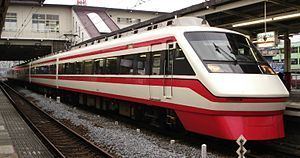Opened August 27, 1899 Line length 75.1 km (46.7 mi) Locale Kantō region | Daily ridership 843,495 (2010) Stations 26 | |
 | ||
Termini Tōbu-Dōbutsu-KōenIsesaki | ||
Japan railway tobu isesaki line 50050 series 51064 mizonokuchi station 3 9 2014
The Tobu Isesaki Line (東武伊勢崎線, Tōbu Isesaki-sen) is a Japanese railway line operated by the private railway company Tobu Railway, extending from Tōbu-Dōbutsu-Kōen Station in Saitama to Isesaki Station in Gunma Prefecture. From March 2012, the southern 41.0 km section of the line was rebranded as the Tobu Skytree Line in conjunction with the opening of the Tokyo Skytree tower.
Contents
- Japan railway tobu isesaki line 50050 series 51064 mizonokuchi station 3 9 2014
- Japan railway tobu isesaki line 50050 series 51061 mizonokuchi station 3 9 2014
- Descriptions
- Service patterns
- Stations
- Rolling stock
- History
- References
Japan railway tobu isesaki line 50050 series 51061 mizonokuchi station 3 9 2014
Descriptions
Service patterns
Stops and operated sections are as of 2013.
Stations
Rolling stock
History
The first section of the Isesaki Line was opened by the present company in 1899 between Kita-Senju and Kuki utilising steam motive power. In 1902, Tobu extended the line south to have a maritime connection at present Tokyo Skytree (then Azumabashi (吾妻橋), later renamed Asakusa) in downtown Tokyo, and north to Kazo. The following year a further northern extension to Kawamata (then on the south bank of Tone River) was opened. Further northward extension progressed, and in 1910 the line arrived at Isesaki. In 1931, a bridge over the Sumida River was built and present Asakusa Station (then Asakusa Kaminarimon (浅草雷門)) opened as part of the department store building, the entire line being completed.
The Asakusa to Nishiarai section was double-tracked in 1912, and the rest of the line was double-tracked between 1920 and 1927, except for the Hanyu to Kawamata section, which was double-tracked when a second bridge was built over the Tonegawa in 1992.
Electrification was begun in 1924 on the section of Asakusa and Nishiarai, and in 1927 completed as far as Isesaki. The distance of over 100 km was then one of the longest electrified railway lines together with the present Kintetsu Osaka Line and Yamada Lines.
After World War II, the Tobu Lines had no connection to the Yamanote Line or other major lines of the then Japanese National Railways (JNR) to offer efficient transfers to central Tokyo. The sole connection was with the Jōban Line at Kitasenju, which offered poor access to central Tokyo. To solve the inefficiencies of transfers at Kitasenju and notoriously narrow Asakusa, in 1962, the Hibiya Line of the then Teito Rapid Transport Authority (帝都高速度交通営団, Teito Kōsokudo Kōtsū Eidan), known as TRTA, present Tokyo Metro) was built, connecting at Kitasenju.
Further growing traffic required Tobu to build a second through line to Tokyo Metro Hanzomon Line in the 1990s. In 2003, the company built new tracks from Hikifune to connect at Oshiage, officially an annex station of Tokyo Skytree.
From the March 3, 2006, timetable revision, less than half of trains originated or terminated at Asakusa, with more trains operating through to Tokyo Metro underground (subway) lines.
From 17 March 2012, the section south of Tōbu-Dōbutsu-Kōen was rebranded as the Tobu Skytree Line.
